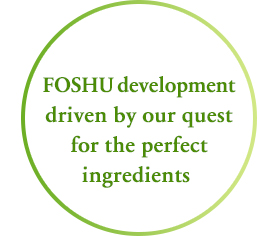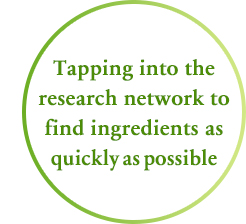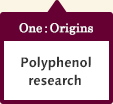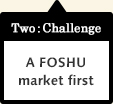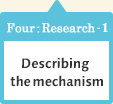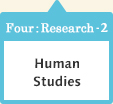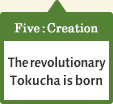- Suntory Global Innovation Center
- > Research & Technology
- > The Tokucha Development Story
- > Chapter 3. The search for a new ingredient that would give rise to Tokucha tea
Research & Technology
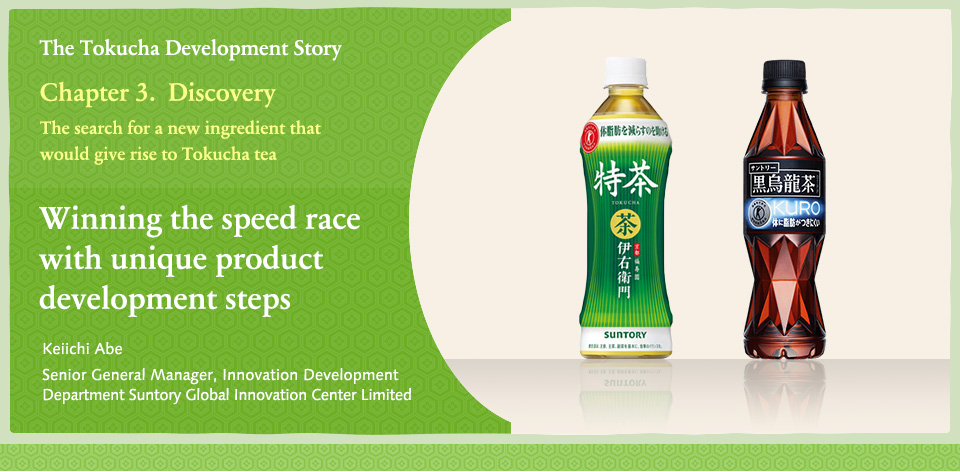
I was immediately assigned to the research labs upon joining the company, where I began my single-minded quest to discover new ingredients. Having taken charge of exploratory research into health-promoting ingredients and pharmaceuticals at my former position was immensely valuable in moving FOSHU product development forward, as it had given me a solid understanding of science and allowed me to build extensive networks in the health ingredients industry. At the same time, I had been able to collect some general information on product development and materials research at our competitors by participating in academic conferences and similar events. Knowing what they were working on allowed me to leverage our strengths somewhat, selecting compounds or ingredients that were both unique and highly promising.
I got involved in research and development as the leader of our new FOSHU project, and then later participated in the special FOSHU project team as well. My job was to come up with product ideas based on unique ingredients. For Kuro Oolong Tea specifically, I was working on establishing a unique manufacturing process and designing the formula based on our discovery that the special OTPP components in oolong tea effectively inhibited fat absorption. Most tea polyphenols have an astringent taste, but OTPP imparts a mouthfeel as smooth as velvet. For this reason, Kuro Oolong Tea has a smooth, layered flavor profile on par with that of a full-bodied red wine—a quality that has certainly contributed to its market success.

In working on the special FOSHU project, my search for ingredients not only taught me the importance of efficacy itself, but also of pinpointing the functional targets that would drive people to purchase and developing recipes that would keep them drinking the product day after day. It was through understanding the importance of an ingredient like OTPP, which had excellent functional target potential and great flavor in addition to being highly effective, that we were later able to develop the Tokucha product.
We anticipated that any beverage that targeted obesity would have massive potential to become a hit product. Drinking Kuro Oolong Tea with a meal inhibited fat absorption, but if we could also find a mechanism to effectively break down and burn fat, we could offer a product that would reduce body fat outside of mealtimes as well.
Suntory had been looking to develop a FOSHU beverage with fat-dissolving and fat-burning effects since before Kuro Oolong Tea was released, but at the time we didn’t have the right ingredient to make it happen. This meant that the entire process from discovering an ingredient to getting FOSHU approval would take a minimum of five years.


Because a FOSHU product targeting obesity was likely to be a major product, we understood that it would be a major opportunity loss if we took too much time to develop it.
We minimized the risk by starting with a list of ingredients that we were confident had development potential.
We started by eliminating ingredients that were too costly or that posed significant problems in terms of taste. We also looked at safety in terms of what was already being safely consumed, and then narrowed down the list to those that were likely to relate to fat-dissolving and/or fat-burning effects according to the existing literature and similar sources. We ended up selecting the polyphenol quercetin, which was derived from Styphnolobium japonicum, a member of the legume family. To be honest, we were quite surprised to discover that a compound as common as quercetin could have powerful anti-obesity effects in humans.
Using this unique, previously untried approach, we were able to greatly reduce our ingredient search to a period of just one year.
Now that we had found our fat-dissolving, fat-burning ingredient quercetin, we quickly began conducting the tests we needed to apply for FOSHU certification. Specifically, we examined the effectiveness of quercetin by having people consume it over a period of three months and seeing whether it caused a reduction in body fat.

We started by making detailed inspections of our testing conditions while comparing them against our hypotheses about how quercetin worked. We had placed a heavy exercise load on our subjects during the ingredient selection tests, but the continuation tests we needed for FOSHU application required that we have them live more normal lifestyles with a more typical level of exercise. We used the results of our preliminary tests to determine the amount of quercetin as well as figure out when the participants should drink it. We pulled out all the stops to make our tests as accurate as possible; for example, to minimize variations in the test data, we never strayed far from the testing site to make sure that the participants received thorough instructions on exactly how to go about their daily activities.
Then, two years after we first took up the challenge, our prayers were answered when we got the test results we were hoping for. Having verified the effectiveness of quercetin, we were able to rapidly push the project towards FOSHU application and accelerate towards the introduction of Tokucha today.
Quercetin is an ingredient with tremendous potential. For example, because it has a powerful anti-inflammatory effect, we are also able to use it in our Glucosamine & Chondroitin supplement; we also are beginning to realize its potential to positively affect the brain, blood vessels, and digestive tract.
In short, Tokucha is more than simply an anti-obesity product—it may have several additional benefits that go beyond what we originally expected. At the Suntory Global Innovation Center, we will continue our quest to bring out the full potential of quercetin.

* The department name, title, and photo are as of the time of the production (interview).
* The department name, title, and photo are as of the time of the production (interview).
